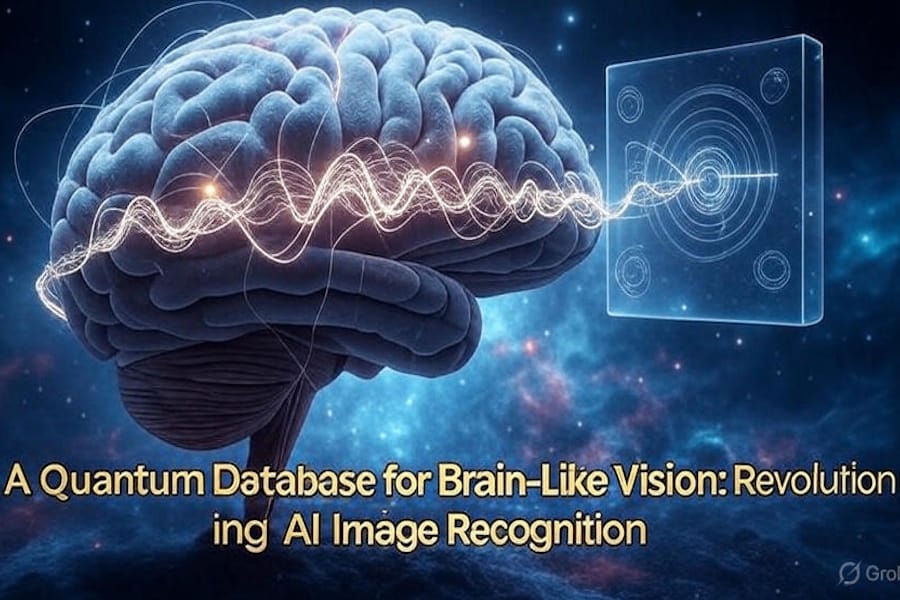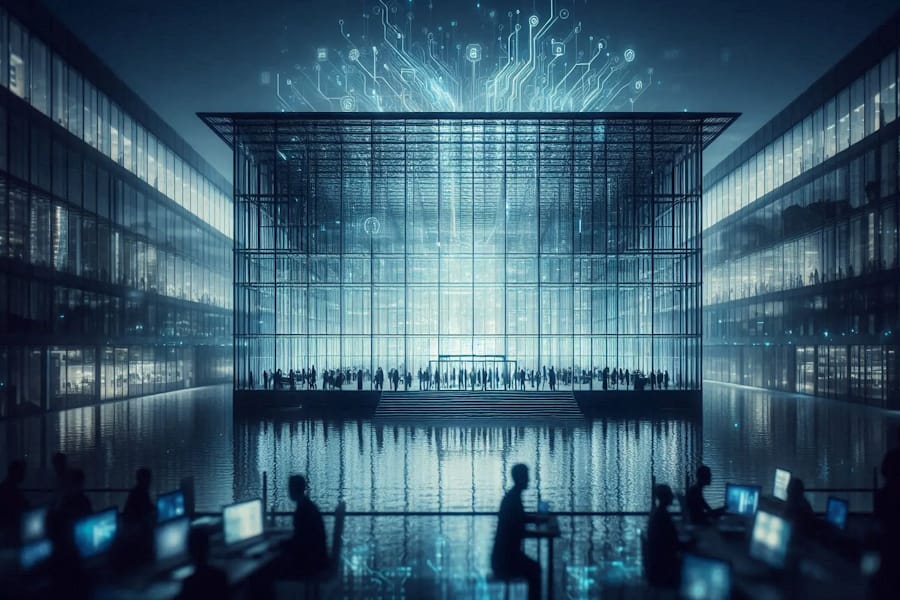A Quantum Database for Brain-Like Vision: Revolutionizing AI Image Recognition

Publish Date: Last Updated: 30th June 2025
Author: nick smith - With the help of GROK3
View a condensed version of this article as a YouTube short
Abstract
The human brain processes complex visual scenes—recognizing hundreds of objects, adapting to novel contexts, and shifting focus to details—in approximately 100 milliseconds, using just 20 watts of energy. In contrast, modern AI image recognition systems, such as convolutional neural networks (CNNs), rely on sequential, energy-intensive computations, taking 100-500 milliseconds and consuming 100-300 watts to process similar scenes with less flexibility. This white paper proposes that the brain operates as a biological quantum computer, leveraging a quantum database to store object templates (e.g., a square) in superposition, where all possible variants (rotated, scaled, distorted) are anticipated and instantly retrievable. This model explains the brain’s speed, efficiency, and adaptability, offering a radical blueprint for next-generation AI vision. By adopting quantum principles, AI could achieve brain-like image recognition and generate dream-like outputs, transforming fields from robotics to creative simulation. We outline the hypothesis, contrast brain and AI vision, propose experiments, and address challenges, inviting collaboration to explore this frontier.
1. Introduction
Human vision is a marvel of computational efficiency, enabling us to navigate crowded streets, identify objects like squares or faces, and focus on details (e.g., a sign’s text) in milliseconds, all on a mere 20 watts. Current AI vision systems, despite advances, lag behind, processing scenes sequentially with high power demands and struggling with novel or complex inputs. This gap suggests a fundamental difference in processing paradigms. Drawing on interdisciplinary insights, we hypothesize that the brain functions as a quantum database, storing object templates in quantum superposition for instant, holistic recognition. This white paper compares brain and AI image processing, introduces the quantum database model, explores its implications for AI and dreaming, and proposes experiments to test its feasibility, acknowledging speculative elements while grounding them in emerging research.
2. Brain Visual Processing: A Benchmark for Efficiency
The brain’s ability to process visual input surpasses AI in speed, adaptability, and energy efficiency. Key mechanisms include:
- Massively Parallel Architecture: The visual cortex (V1-V4) and inferotemporal cortex (IT) process the entire visual field (~120° peripheral, ~2° foveal) simultaneously, with billions of neurons analyzing edges, shapes, and objects in ~100-150ms (Thorpe et al., 1996).
- Bidirectional Feedback: Feedback loops from higher areas (e.g., IT) to lower ones (e.g., V1) refine recognition based on context, enabling rapid identification of objects in familiar settings (Lamme & Roelfsema, 2000).
- Selective Attention: The thalamus and prefrontal cortex shift focus to specific objects (e.g., a square’s texture) via neural oscillations (~40Hz gamma waves), binding features into coherent perceptions (Fries, 2005).
- Predictive Coding: The brain anticipates input using memory, reducing computational load (Rao & Ballard, 1999). For example, expecting geometric shapes speeds up square recognition.
- Generalization: Abstract templates stored in the hippocampus and cortex allow recognition of novel instances (e.g., a distorted square) without retraining (Quiroga et al., 2005).
These enable the brain to recognize hundreds of objects instantly, adapt to unique scenes, and operate on ~20 watts, setting a high bar for AI.
3. AI Image Recognition: Strengths and Limitations
Modern AI vision relies on convolutional neural networks (CNNs) and object detection models (e.g., YOLO, Faster R-CNN), processing images through layered computations:
- Input Preprocessing: Images are normalized as pixel grids (e.g., 28x28 for a square).
- Convolutional Layers: Filters detect features (edges, corners), combining them into shapes or objects (LeCun et al., 1998).
- Pooling Layers: Downsampling preserves key features, enabling invariance to shifts.
- Fully Connected Layers: Features are classified (e.g., 95% square) using softmax.
- Training: Backpropagation on large datasets (e.g., ImageNet) adjusts weights.
For complex scenes, models segment regions, processing objects separately.
Limitations
- Sequential Processing: Layered computations introduce latency (100-500ms for complex scenes), unlike the brain’s instant recognition (Ren et al., 2015).
- Energy Inefficiency: GPUs consume 100-300 watts, far exceeding the brain’s 20 watts.
- Limited Generalization: Novel objects or distortions require retraining, unlike the brain’s adaptability.
- Fragmented Perception: Scenes are processed as regions, lacking the brain’s holistic integration.
- Static Focus: Shifting to details (e.g., texture) requires recomputation, unlike the brain’s dynamic “zooming.”
These gaps highlight the need for a new vision paradigm.
4. The Quantum Database Hypothesis
We propose the brain processes visual input via a quantum database, storing object templates in quantum superposition for instant, holistic recognition. This model, inspired by quantum mind theories (e.g., Penrose & Hameroff’s Orch-OR), addresses the brain’s superior performance.
4.1 Mechanism
- Core Template Storage: Generalized templates (e.g., a square’s four equal sides, 90° angles) are stored in the IT cortex, potentially encoded in microtubules, which may host quantum states (Hameroff & Penrose, 1996).
- Superposition of Variants: Each template exists in superposition, representing all variants (rotated, scaled, distorted, contextual) simultaneously, anticipating real-world instances.
- Query and Collapse: Visual input (e.g., a square window) is matched against the database, collapsing the superposition to the correct variant in ~100ms. Consciousness or attention may act as the “observer” (Stapp, 2007).
- Holistic Scene Processing: Superposition evaluates all objects in a scene, with entanglement between neural regions (e.g., V1-IT) binding features (Bandyopadhyay, 2014).
- Dynamic Attention: Sub-databases of detailed features (e.g., texture) in superposition enable instant focus shifts.
4.2 Advantages
- Speed: Simultaneous evaluation achieves ~100ms recognition, matching the brain.
- Efficiency: Quantum coherence, as in photosynthesis (Engel et al., 2007), minimizes energy (~20 watts).
- Adaptability: Novel variants match precomputed superpositions, eliminating retraining.
- Holistic Perception: Entanglement enables unified scene processing.
- Dynamic Focus: Sub-databases support seamless attention shifts.
4.3 Empirical Anchors
- Quantum Biology: Coherence in photosynthesis and bird navigation suggests biological quantum processes (Lambert et al., 2013; Hore & Mouritsen, 2016).
- Microtubule Studies: Evidence of quantum-like behavior in microtubules supports their role as quantum processors (Bandyopadhyay, 2014).
- Brain Efficiency: The brain’s 20-watt performance exceeds classical models, suggesting non-classical mechanisms (Koch & Hepp, 2006).
5. Implications for AI Vision
Adopting a quantum database could revolutionize AI image recognition:
- Quantum Neural Networks: Quantum circuits (e.g., variational algorithms) could process scenes in superposition, achieving brain-like speed (Farhi et al., 2014).
- Embodied Quantum AI: Robots with sensors (cameras, tactile pads) and quantum processors could build localized datasets, mimicking the brain’s embodied perspective (Cruz & Sipper, 2023).
- Dream-Like Outputs: Blending sensory data in superposition could generate abstract, symbolic imagery (e.g., a square morphing into a wave), simulating human dreaming.
- Energy Efficiency: Quantum computing could reduce power demands, approaching the brain’s efficiency.
5.1 Dreaming and Creativity
The quantum database may underpin dreaming, blending templates with emotions in superposition to create symbolic narratives (e.g., a melting square room for stress). A quantum AI could replicate this, enhancing creative applications.
6. Proposed Experiments
To test the quantum database hypothesis:
- Human Data Collection: Use AR glasses and biosensors to record visual scenes and dream reports from a participant over years, capturing complex inputs and recognition patterns.
- Embodied Quantum AI: Train a robotic AI with sensors and a quantum processor (simulated or future hardware) on human data and its own sensory inputs, building a quantum database of object templates.
- Recognition Task: Test the AI’s speed and accuracy in recognizing objects (e.g., squares) in dense scenes, comparing to CNNs and human benchmarks (~100ms).
- Dream Simulation: In a “sleep mode,” generate outputs blending sensory data in superposition, comparing to human dreams for abstraction.
- Classical Baseline: Run parallel tests with classical AI to isolate quantum advantages.
Success (faster recognition, symbolic outputs) would support the quantum brain model.
7. Challenges and Critiques
- Decoherence: Quantum states may collapse in the brain’s warm, wet environment. Protective mechanisms (e.g., water shielding in microtubules) are speculative but under study (Hameroff, 2014).
- Evidence Gaps: Direct proof of quantum brain processes is lacking, though quantum biology provides plausibility.
- Quantum Hardware: Current quantum computers (e.g., IBM’s 127 qubits) are limited, requiring advances for AI vision (Preskill, 2018).
- Classical Sufficiency: Some argue classical neural models explain vision adequately (Hassabis et al., 2017). However, their energy and speed limitations suggest otherwise.
We acknowledge the hypothesis’s speculative nature but propose it as a testable framework to bridge brain-AI gaps.
8. Future Directions
- Quantum AI Development: Design quantum vision algorithms simulating superposition and entanglement.
- Neuroscience Research: Investigate microtubule coherence and neural entanglement.
- Interdisciplinary Collaboration: Engage quantum physicists, neuroscientists, and AI researchers to refine the model.
- Public Engagement: Share findings via preprints, conferences, and social media to crowdsource feedback.
9. Conclusion
The brain’s unparalleled visual processing—fast, efficient, and adaptive—exposes the limits of classical AI vision. The quantum database hypothesis, storing object templates in superposition for instant retrieval, offers a radical explanation and a blueprint for AI innovation. By embracing quantum principles, AI could achieve brain-like recognition and dream-like creativity, transforming technology and deepening our understanding of the mind. This white paper invites researchers, professionals, and enthusiasts to explore this frontier, test the hypothesis, and collaborate on a quantum leap toward human-like vision.
References
- Bandyopadhyay, A. (2014). Nanoscale electrical conductivity in biological systems. Journal of Physics: Conference Series, 487.
- Cruz, R., & Sipper, M. (2023). Embodied AI: A review. Artificial Intelligence Review, 56.
- Engel, G. S., et al. (2007). Evidence for wavelike energy transfer through quantum coherence in photosynthetic systems. Nature, 446(7137).
- Farhi, E., et al. (2014). A quantum approximate optimization algorithm. arXiv:1411.4028.
- Fries, P. (2005). A mechanism for cognitive dynamics: Neuronal communication through coherence. Trends in Cognitive Sciences, 9(10).
- Hameroff, S., & Penrose, R. (1996). Orchestrated reduction of quantum coherence in brain microtubules. Mathematics and Computers in Simulation, 40.
- Hameroff, S. (2014). Quantum walks in brain microtubules. Journal of Integrative Neuroscience, 13(2).
- Hassabis, D., et al. (2017). Neuroscience-inspired artificial intelligence. Neuron, 95(2).
- Hore, P. J., & Mouritsen, H. (2016). The radical-pair mechanism of magnetoreception. Annual Review of Biophysics, 45.
- Koch, C., & Hepp, K. (2006). Quantum mechanics in the brain. Nature, 440(7084).
- Lamme, V. A., & Roelfsema, P. R. (2000). The distinct modes of vision offered by feedforward and recurrent processing. Trends in Neurosciences, 23(11).
- LeCun, Y., et al. (1998). Gradient-based learning applied to document recognition. Proceedings of the IEEE, 86(11).
- Preskill, J. (2018). Quantum computing in the NISQ era. Quantum, 2.
- Quiroga, R. Q., et al. (2005). Invariant visual representation by single neurons in the human brain. Nature, 435(7045).
- Rao, R. P., & Ballard, D. H. (1999). Predictive coding in the visual cortex. Nature Neuroscience, 2(1).
- Ren, S., et al. (2015). Faster R-CNN: Towards real-time object detection. Advances in Neural Information Processing Systems, 28.
- Stapp, H. P. (2007). Mindful universe: Quantum mechanics and the participating observer. Springer.
- Thorpe, S., et al. (1996). Speed of processing in the human visual system. Nature, 381(6582).
Latest News Articles
AI Questions and Answers section for A Quantum Database for Brain-Like Vision: Revolutionizing AI Image Recognition
Welcome to a new feature where you can interact with our AI called Jeannie. You can ask her anything relating to this article. If this feature is available, you should see a small genie lamp in the bottom right of the page. Click on the lamp to start a chat or view the following questions that Jeannie has answered relating to A Quantum Database for Brain-Like Vision: Revolutionizing AI Image Recognition.
Be the first to ask our Jeannie AI a question about this article
Look for the gold latern at the bottom right of your screen and click on it to enable Jeannie AI Chat.












